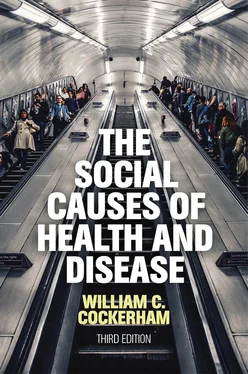Social Determinants of Disease: Fundamental Cause Theory
The seminal theoretical work on the role of social factors in disease causation in medical sociology is that of Bruce Link and Jo Phelan (1995, 2000; Carpiano, Link, and Phelan 2008; Phelan and Link 2013, 2015; Phelan, Link, and Tehranifar 2010). Link and Phelan maintain that social conditions are fundamental causes of disease. In order for a social variable to qualify as a fundamental cause of disease and mortality, Link and Phelan (1995: 87) hypothesize that it must (1) influence multiple diseases, (2) affect these diseases through multiple pathways of risk, (3) be reproduced over time, and (4) involve access to resources that can be used to avoid risks or minimize the consequences of disease if it occurs. They define social conditions as factors that involve a person’s relationships with other people. These relationships can range from ones of intimacy to those determined by the socioeconomic structure of society.
Link and Phelan conclude that there is a long and detailed list of mechanisms linking socioeconomic status with mortality. In addition to stratification variables such as class, race, and gender, stressful life events and stress-process variables like social support qualify as social factors. Also included is a sense of control over one’s life because people with such control typically feel good about themselves, cope with stress better, and have the capability and living situations to adopt healthy lifestyles. This situation may especially apply to people in powerful social positions. “Social power,” state Link and Phelan (2000: 37), “allows one to feel in control, and feeling in control provides a sense of security and well-being that is [health-promoting].” Persons at the bottom of society are less able to control their lives, have fewer resources to cope with stress, live in more unhealthy circumstances, and face powerful constraints in adopting a healthy way of life, and die earlier. Consequently, Link and Phelan argue that broadbased societal interventions may be able to produce more substantial health benefits than individually-based intervention strategies in many situations.
Of particular interest as a structural variable is social class or socioeconomic status (SES). A person’s class position influences multiple diseases in multiple ways and the association has endured for centuries. Numerous studies have linked low SES with worse health and higher mortality throughout the life course (Atkinson 2015; Carr 2019; Laditka and Laditka 2019; Marmot 2015). Even accounts of the black or bubonic plague ( Yersina pestis ) in Europe in the fourteenth century describe how the poor were more heavily afflicted than the rich and note that the common people suffered the most (Cantor 2015). In advanced societies like the US and Britain, people generally live 30 more years on the average than they did in 1900. Over 80 percent of all deaths occur past the age of 65, with poor people living longer today than the wealthy did in past historical periods. But the gap remains the same in that while everyone typically lives longer today, people in the upper social strata live the longest. Consequently, Link and Phelan argue that the level of socioeconomic resources a person has or does not have, such as money, education, status, power, and social connections, either protects his or her health or brings on sickness and premature mortality. Phelan et al. (2004: 267) state:
These resources directly shape individual health behaviors by influencing whether people know about, have access to, can afford and are motivated to engage in health-enhancing behaviors. Current examples include knowing about and asking for beneficial health procedures; quitting smoking; getting flu shots; wearing seat belts and driving a car with airbags; eating fruits and vegetables; exercising regularly; and taking restful vacations. In addition, resources shape access to broad contexts such as neighborhoods, occupations, and social networks that vary dramatically in associated profiles of risk and protective behaviors. For example, low-income housing is more likely to be located near noise, pollution, and noxious social conditions and less likely to be well served by police, fire, and sanitation services; blue-collar jobs tend to be more dangerous and stressful than white-collar and to carry inferior health benefits; and social networks with high status peers are less likely to expose a person to second-hand smoke, more likely to support a health enhancing lifestyle, more likely to inform a person of new health-related research, and more likely to connect him or her to the best physicians.
Phelan et al. confirmed their thesis that socioeconomic status is a fundamental cause of mortality by finding a strong relationship between SES and deaths from preventable causes. For deaths from less preventable causes about which little is known in terms of prevention and treatment, the relationship was less strong. However, people with higher SES had significantly higher probabilities of survival from preventable causes of death because they were able to use their greater resources to that end. Their enhanced access to and effective use of resources (money, knowledge, etc.) served as the social mechanism allowing them to obtain greater longevity. Such resources also shape broader contexts affecting health like jobs, neighborhoods, and social networks that vary dramatically in promoting protection or risk. These resources are flexible because they can be used in varied circumstances. Their availability is central to understanding the operation of the theory at both individual (micro) and contextual (macro) levels because the deployment of resources is critical to health. At the individual level, Phelan et al. (2010: S30) describe flexible resources as the “causes of causes” or “risks of risk” that influence individual health behaviors with respect to whether people know about, have access to, can afford, and are motivated to engage in health-promoting practices, as well as determining access to jobs, neighborhoods, and social networks that vary dramatically in the amount of risk and protection they provide. Resources and the ability to use them are most effective for preventable causes of mortality and less so or ineffective for those that are not preventable or treatable, such as diseases and disabilities associated with aging.
Fundamental cause theory and its concept of flexible resources can also be applied to an infectious disease like COVID-19, as people with such resources were better able to successfully socially distance themselves from others and utilize their socioeconomic advantages to have food and medicine delivered, be entertained and communicate electronically, have teleconferences with health care professionals when required, and know what to do to avoid infection and take the measures necessary to achieve this goal. People with jobs requiring computer skills could work at home and remain employed. Conversely, lesser educated individuals were more likely to work in jobs with greater exposure to infection or be unemployed as the pandemic progressed over time. An exception regarding exposure would be health care workers on the front-line battling the infection in their patients.
When fundamental cause theory is reduced to its most basic proposition, it is the idea that resources consisting of money, knowledge, power, prestige, and social connections are vital to maintaining a health advantage. Conversely, an absence or shortage of these resources causes poor health outcomes and earlier deaths. People with resources have less risk of exposure to preventable diseases in the first place and are better able to achieve positive outcomes when they occur by employing their resources. Persons with lower income, education, and social status lacking such resources not only have greater exposure to risk and more likelihood of the risk being realized, but also a diminished capacity for preventing negative consequences. This is seen in a study by Virginia Chang and Diane Lauderdale (2009), who observed how people in higher socioeconomic groups embraced the widespread use of statin drugs to reduce cholesterol levels and lower their risk of heart attacks before those lower on the social gradient. Once generic, lower-cost statin drugs became readily available, their use extended more extensively into the working and lower classes but, more slowly, as tests for high cholesterol required visits to physicians on the part of the individual.
Читать дальше












